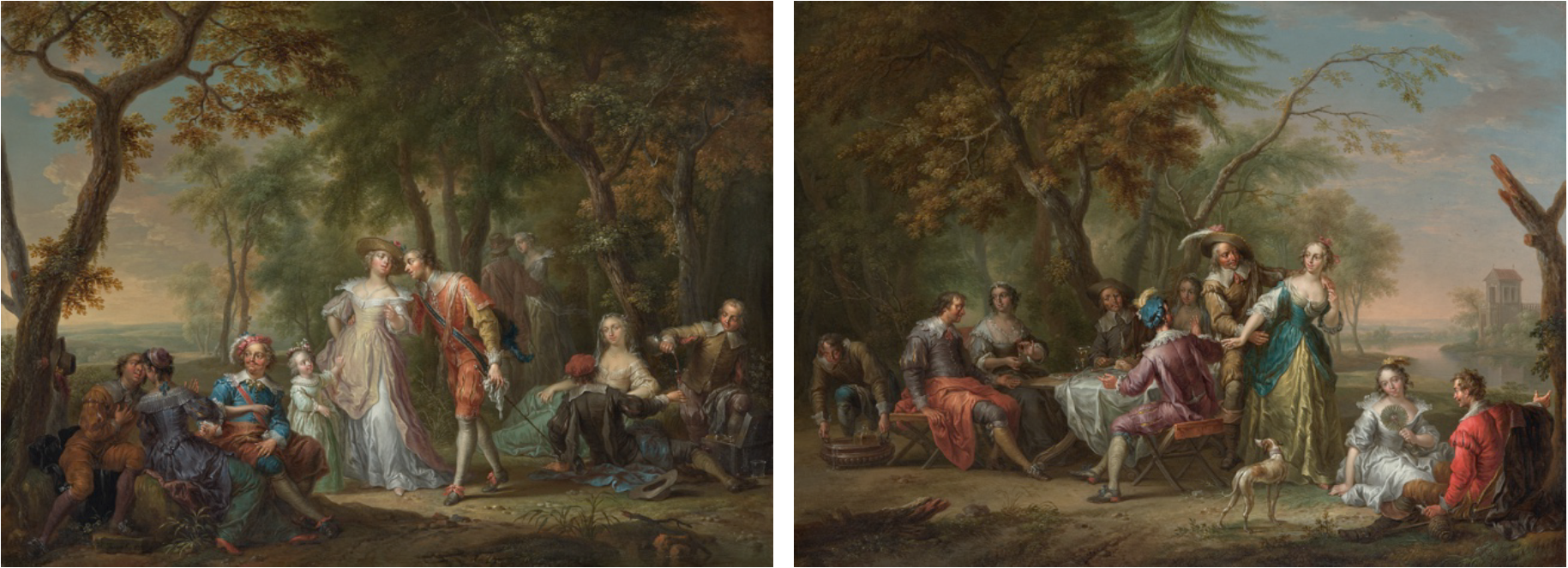Franz Christoph Janneck
(Graz 1703 - 1761 Vienna)
Fête Champêtre - a Pair, c.1750
Oil on copper, each 42 x 57 cm
The left painting signed lower left F.C. Janneck fe:
Provenance:
Captain W. S. Mitford, Pitshill, Petworth, England[1]
London, Christie’s, auction sale, 16 May 1952
Purchased by ‘Morrison’ at the above sale for £580
Vienna, Dorotheum, auction sale 567, 23 March 1965, lots 60 and 61, repr. (sold for 140,000 and 130,000 Austrian Schillings)
Georg Schäfer private collection, Schweinfurt
German private collection
Literature:
Peter Pötschner, Wien und die Wiener Landschaft. Spätbarocke und biedermeierliche Landschaftskunst in Wien, Salzburg 1978, p. 19, fig. 7; p. 293
Dr. Christina Pucher will include the present pair of paintings under no. 103 and no. 104 in her forthcoming catalogue raisonné of Janneck’s work.
Fête champêtre motifs catered to the Rococo yearning for luxe and courtly amusement and as depictions of luxury, leisure and festivity are far removed from the powerful rhetoric and pathos of Baroque history painting. Unsurprisingly, in Franz Christoph Janneck’s lifetime his paintings were in high demand in aristocratic and bourgeois circles. In the sixteenth century, every Viennese aristocrat harbored aspirations of a private palace located as near as possible to the Court, but now the ultimate benchmark of success was a garden palace beyond the city walls. Key examples of this new trend are Schönbrunn Palace and Prince Eugene’s Belvedere.
The historical costumes and idealized landscape setting depicted in this pair of paintings take the viewer back in time, triggering immediate associations with the courtly world of seventeenth century France and the sumptuous festivities of Louis XIV’s reign. The dazzling royal court at Versailles was the trendsetter of the age, setting the tone for the courts of Europe until well into the eighteenth century.[2] The two paintings celebrate a Baroque festivity in all its opulence. Wine is flowing freely, tongues are loosened and senses aroused. Some of the participants converse in groups while others hasten away to indulge in erotic pursuits.
Copper was Janneck’s preferred support for his paintings. Although this obliged his patrons to dig even deeper into their pockets the results were worth every ducat. The burnished copper ground provided a surface as smooth as porcelain and produced an astonishing coloristic luminosity.
After training under his father in Graz, Janneck moved to Vienna in 1721. He completed his studies at the Academy of Fine Arts. The Academy reopened in 1726 under a new director, Jacob van Schuppen (1670-1751), who was a staunch advocate of seventeenth-century Dutch and Flemish pictorial tradition. He taught his students to respect historical values and also encouraged the study of contemporary trends in French genre painting, which emulated the style of Watteau. In 1751 Janneck, like his colleague Paul Troger, was granted an honorary professorship at the Academy. In the following year Janneck was appointed as Assessor. When Christian Ludwig Hagedorn (1712-80) published his Lettre à un Amateur de la Peinture in 1755 he drew to a large extent on research material Janneck had gathered.[3] Hagedorn was later named Inspector of the Dresden Gemäldegalerie. His writings provide an important record of Janneck’s close friendship with the South Tyrolean artist Johann Georg Platzer (1704-61). Janneck and Platzer rank as the leading exponents of Rococo cabinet painting in Austria.
[1] William Slade Mitford (1898-1966) was a lieutenant in the 17th Lancers, a British cavalry regiment. See <https://www.wikitree.com/wiki/Mitford-62> (accessed 29.06.2017).
[2] Roswitha Juffinger, Reich mir die Hand, mein Leben. Einladung zu einem barocken Fest mit Bildern von Johann Georg Platzer und Franz Christoph Janneck, exhib. cat., Salzburg, Residenzgalerie 1996, p. 7.
[3] For a biography of Janneck, see Juffinger, op. cit., pp. 9-14; AKL [Allgemeines Künstlerlexikon] LXXVII, 2013, p. 305.

